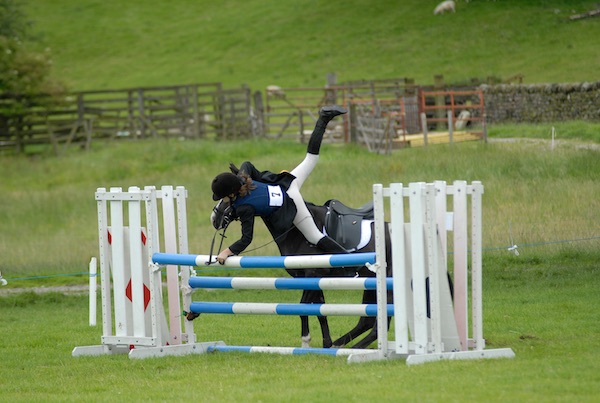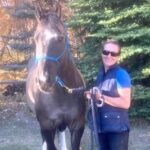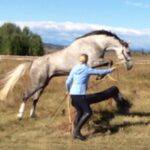
Sitting with fear — riding and horse training
If you’ve ever had a horse-related accident or injury, you know that distinct feeling of residual fear that appears when you step up into the stirrup the first time. I grew up with the notion to bury any fearful experience, ride through it, and just plain “toughen up.” This attitude got me through a few rides, but, as with some other antiquated methods in riding and horse training, came back to bite me later.
Feelings of fear are supposed to engage the self-preservation instinct, but they can also — frustratingly –limit or freeze a rider. The brain has an uncanny knack for convincing us that we’d be better off taking up knitting! “Just hang here with me” says Sofa “until the fear passes.”
Yes, it’s important to debrief after a scare, figure out why it happened, but the longer we sit upon the sofa, the more difficult it becomes to get back in that proverbial saddle. So, what’s the alternative to letting that fear emotion run rampant over the mind, leading us further away from where we really want to be?
To start the healing process to get back to our ride, it’s important to address the negative narrative that stirs up feelings of incompetence, shame, or hopelessness. Replaying and overthinking when mentally in the wrong place can easily deepen vulnerability, self-doubt and feelings of failure.
What if instead we first accept what is, then work one step at a time, at a comfortable rate of progression, to find our way back? Small gradual steps will ensure we do not override the messages from our bodies that can tell us when to take the next step. If we rush when we’re not ready, if we push through, that’s when the tightness and rigidity manifests in the body (and which ultimately gets picked up in the horse).
When you’re coming back from a fearful episode, even the simple act of haltering and leading your horse from the field can be enough for both you and your horse. Small interactions when you feel safe, such as grooming or leading in an enclosed space, can help you regain your confidence. Until you feel secure again, focusing on groundwork with your horse is good for both.
Similarly, in the studio under the guidance of an intuitive teacher, body work will help improve your own self-confidence. Movement practice regulates breathing patterns and guides your body through times of vulnerability. Pilates practice can help you notice whether you are stuck in survival mode still or open to learning. What is held in your body from the incident or experience can be gently worked through, utilizing specific guided movements and focused attention.
As an equestrian, I have never liked being out of control with fear in the driver’s seat so after an incident I tend to want to face any fear or discomfort head on. But for a lot of years, I had no idea there was a valid “go slow” option. Along with the discomfort I felt, my frustration with the fear caused me anxiety and tension that it was hindering my progression with mounted work. Trying to get back too quickly, shutting down fear or from fear, was not going to help me feel better. And now I know, as well, it won’t let anyone heal and grow.
Ultimately the goal is to ride with mutual confidence with an equine partner, so that they do whatever task asked of them, whether to walk calmly down the trails or a 3 ft jump course. The goal is not the task but developing the relationship, and just as with human relationships, trust is key. And as you build confidence and mutual respect through GW with your horse, the possibilities of what can be further accomplished will eventually help diminish any lingering residual fear. Likewise, specific movement work can also retrain the human body to deal with fear and its residue.
We are unintentional hoarders of our past experiences. Not only does historical trauma get in the way of our relationship with our horse but so do rigid, antiquated beliefs. For the past few years I’ve used movement to getting unstuck from my own history. I’ve realized that what I was seeing as “failure” wasn’t the opposite of success — it was just part of the process. The road to success is neither short nor straight!
Name what you are feeling, it will ease the fear. When you leave fear unexamined that is what makes it so threatening.
The stark realization that I could not help my horse when stuck with fear forced me to take small steps to unravelling the sensations through movement, which was both productive and positive. The commitment to taking care of my body deepened my awareness and expanded my courage. I feel calmer than ever, with more surety of purpose. Mindful movement unleashes that necessary awareness and paired with patience, is perfect for horse and rider in accepting, then addressing, the fear.
Fear – frustration – acceptance – curiosity – movement
If you sit rooted in the quagmire of fear, you become stagnant. The more you move with intention, the clearer you will feel and deepen your breath to relieve the nervous anxiety. Groundwork settles a horse’s stressed state into a more relaxed frame of mind. When pressure is lowered and communicated through GW, many horses find it easier to integrate information and build confidence. The journey of awareness on this level has taken trainers, clinicians and general equestrians years of investigation to see the immense benefits. GW became more compassionate and gentle to restore balance with the horse through observation and communication. So, why on earth do we not see how the same approach can help us riders?
Establishing reliability, consistency and a secure base helps manage your relationship.
Your relationship with your horse is based on the trust from building a healthy working relationship. If a rider’s behaviour is defensive, tone unfriendly, that is what is communicated verbally and energetically.
Our emotion “Fear”
All of our emotions have a role, and the challenge is to not let the common emotion of fear thrive. When we shift into a state of arousal due to stress and trauma, when our bodies are in (flight, fight or freeze) state we revert to survival mode. When we are fearful, a shift in our biochemistry deprioritizes the general housekeeping that looks after our physical body as blood flow is diverted away from other areas (gastrointestinal, for example). Our trauma has to go somewhere. For many of us it translates to reduced range of motion in some or all of our soft tissues, and/or being stuck in a pain cycle, where no learning or progressing can happen. (more on pages 28-29 Tool Kit — Preview)
For our body to heal, we have to be in a healing state. Our mind and emotions can affect the physical body and vice versa. To be ready for healing, our bodies need to be soothed into a parasympathetic state and returned to normal breath, appetite and activities — where we relax, digest, and our heart rate decreases, etc. Guided mindful movement can transform a stressed state into a healing state. With particular attention to our breath, small gains are slowly achieved by choosing familiar practices that have a noticeable effect on our state of mind.
Pilates is an amazing method to interconnect physical and mental levels through movement and breath (more on page 36 Tool Kit — Preview) and it can complement your horse’s groundwork and your ride.
Fear can be temporary, this much I know, and if we aim for more freedom of movement, more peace than anxiety, more acceptance than judgement, life will more joyful than fearful for both us and our horses.
[It’s all about appreciating the marginal gains, which will be the next topic I’ll discuss in more detail.]
NOTE: Sometimes the change in approach to your fear requires the help of a different method, coach, or trainer. Talk to someone more experienced who can help assess you and your horse, and the situation that caused your fear.

Amy Krazizky
Pilates Teacher
***
Tracey and I have been training together for a while now; I strongly believe that we were meant to cross paths. She has helped me translate what I do with human clients through Pilates body work, into my own training with my horses and their body work. The result has been a positive development for me — a new specialization with equestrians. Please read on to hear from Equestrian Trainer Tracey Skinner ……
***
Tracey’s view
We’ve all heard it, especially those of us who have been riding for most of our lives: “You have to ride through it.” Pressure to ride through a frightening situation could be coming from a coach, a peer, or even our ego. The antiquated belief suggests if you get off, the horse is winning, or getting away with a bad behaviour. In my experience, that’s just not true. Okay, sure, if you bring them back to the barn and give them cookies, that would be rewarding unwanted behaviour. However, if you step off and work them productively on the ground to get through the situation, get back in the moment and find connection with your horse, you’ll be able to turn a negative situation into progress.
I have solved many training challenges by stepping off, handling it on the ground where I feel safe and confident, then getting back on to finish with a positive ride. When we are fearful, riding through it is not a win, for horse or rider. Once we are in an emotional state of fear, we are no longer capable of being present with our horses, let alone ourselves. What our horses truly need from us is to be present and aware of ourselves and of them.
The adult clients who have come to me with experiences of being pressured into riding when in a state of fear were all left with residual emotions that became a block to their growth. Their stories share similar themes:
- Their instinct told them it was a dangerous situation; they wanted to get off.
- Their trainer at the time and/or their belief system pressured them to stay on and ride through it.
- They stayed on, acting in a fear state; the situation escalated, and they lost control and were traumatized by the incident.
- This situation brought to fruition the fear of physical danger, and has left them with residual fear, not to mention the negative emotions that come with it.
These experiences all shared the same outcome — fear of re-living that situation. For some it is a fear of cantering, for others it is a fear of riding out on the trail, or of riding out in an open space, and the list goes on. No one wants to be in a fear state, and many people don’t know how to overcome it. When we don’t know what to do, fear takes over to give us a million scenarios of “what if’s” and most are not positive outcomes!
I think it’s fair to say that fear and confidence cannot exist together. Fear can inhibit growth. Confidence comes with knowing how to handle a situation in the moment. Breaking a situation down, and overcoming smaller obstacles is a way to break the fear cycle. Groundwork builds my confidence in my horse, as well as gives my horse confidence in me. I always go back to the basics, on the ground, where clear communication becomes possible. Once the horse is responding well and following the direction of the person, the building of confidence between horse and person begins.
Here’s an example: I recently took my young warmblood mare to get experience with cattle, aware of her athleticism, and her potential to have a very big reaction to something she has never experienced before, especially something alive and moving that I cannot control. If she really reacted, there was only a slim chance that I would be capable, let alone have the confidence to ride it out. To make a long story short, instead of the cattle, 3 fast and frisky buffalo were let into the arena!
Thankfully I had chosen to do the session on the ground. I was confident in my capability of being able to direct her energy/body* keeping her away from me, keeping myself safe and able to remove both of us from the arena when she was in an extremely heightened state of fear. I was able to move her body parts and direct where she was putting her feet. I was able to bring her mind back into her body enough for us to safely leave. The buffalo were too much for the both of us, but we finished the day with doing some nice groundwork in a pen with 3 very well-behaved steers. And yes, my ego gave me a hard time for not finishing in the saddle or conquering the buffalo. But there is no room for ego in my relationship with my horse. The important thing was that we finished the session having confidence in each other. The next time we rode with cattle went well. We’ll revisit the buffalo one day when our connection is a little bit stronger!
When a riding issue arises, I do my best to support students with problem-solving in the saddle, as long as they have the confidence to handle it. Sometimes, the confidence to stay on and work through a challenge comes from knowing it’s OK to get off at any moment. If they are not comfortable, I will have them address and solve it on the ground, have them get back on, breathe, let go of it and carry on with their ride. If it’s a training issue that is beyond the student’s skill set, that is when I’ll step in and take the reins.
What I’m trying to say is, it’s ok to get off, or even not get on. It is so important that no matter what the situation was, you should always end your session feeling good about it. If it’s all falling apart, it might mean taking it back to a small ask that you know you and your horse can do and be successful.
A very important component of good groundwork is having the control of our own bodies, physically and emotionally. With my practice of Pilates has come a heightened awareness and the skills to be in conscious control of my own movements. Our horses read us: in a stressful situation, they need us to be stable in our body/core, present in our minds and in control of our emotions. Pilates gives us the tools to be present with ourselves, just as groundwork gives us tools to help our horses be present and “with” us.
Groundwork is an excellent way to break things down and problem solve. Many people have a misconception that groundwork is just running your horse around in circles, maybe a few quick changes of direction. That is mindless and really does nothing other than help them burn off excess energy. Good groundwork, like Pilates work, is thoughtful and conscious connection. Asking the horse to move very specifically and be connected mentally means much information can be shared and progress made.
We have to accept fear. Let’s face it, without fear, we would constantly be in reckless situations and all sorts of trouble! We can even look at fear as our friend. It is there to keep us safe, to warn us of potential danger. However, like some friends, fear can overstep boundaries, be clingy and show up uninvited. If left unchecked, fear can take over and turn the relationship toxic.
Listen to your fear — are you in an unsafe situation? If so get out, get off, do what you need to do to be safe. There should be no shame or embarrassment to this — that is all ego-based. If you are not in imminent danger, but your mind is giving you all the what-if scenarios, understand and acknowledge fear has railroaded the scene. Question it. Does it come from a past experience? Does it come from hearing a story about someone you know, or don’t even know? Fear shouldn’t inhibit; its job is to make us aware, and in tune with our own bodies’ reactions, and should not interfere with the relationship we have with our horses. Unfortunately, all too often, it is there lurking, waiting for the moment to spring up and debilitate us from moving forward.
The first time the thought to get off enters your mind, get off. Intuition is usually right. Keeping yourself safe should be your first priority. Use your ground skills to work through the situation and get you to a place where you are confident to get back on. When you develop the right skills on the ground, respect, body control and connection, you can easily redirect stressful energy into productive energy. And when you get back in the saddle, you’ll be ready to let go of the past.

Tracey Skinner
Equestrian Trainer
